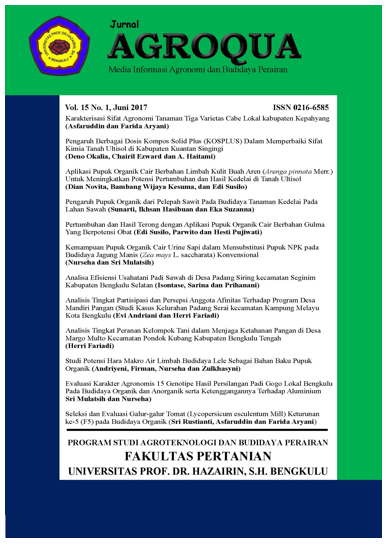PERANAN HERBISIDA GLIFOSATE DAN AIR KELAPA FERMENTASI DALAM MENGENDALIKAN GULMA DI PERKEBUNAN KELAPA SAWIT YANG BELUM MENGHASILKAN
Keywords:
Glyphosate, water coconut fermented, weed, concentration, dose, palmAbstract
This study aims to determine the effect of concentrations and doses of glyphosate plus fermentation of coconut water weed in oil palm plantations that have not produced. The experiment used a randomized block design arranged in factorial. The first factor is the concentration of herbicide combination (H) consisting of: H1 = concentration of glyphosate + 2 ml to 200 ml coconut water fermented, H2 = 4 ml concentration of glyphosate + 100 ml coconut water fermented. The second factor is the dose given (D), namely: D1 = 250 l / ha, D2 = 500 l / ha and D3 = 750 l / ha. Each treatment was repeated 3 times. The study
concluded: (a) type of weed obtained in oil palm plantations are 19 types. Weeds are predominantly Ischaemum muticum (grasses) (28.6%), followed by weeds Scleria sumatranensis (teki) (24.7%), Tetrasera indica (broad leaves) (10.6%), Leersia hexandra (grasses ) (7.2%) and Imperata cylindrica (grasses) (6.4%). Five important weeds have already mastered a land area of 77.5%, (b) the herbicide glyphosate at a concentration of 2 ml of water mixed with 200 ml per liter of fermentation of coconut water and glyphosate with a concentration of 4 ml was mixed with 100 ml of fermented coconut water is able to kill weeds in plantation palm immature, (c) Dosing liquid spray as much as 250 l / ha, 500 l / ha and 750 l / ha was able to kill weeds in oil palm plantations immature, (d) there is no interaction between the concentration and amount of fluids given in control weeds in immature oil palm plantations.
Keywords: Glyphosate, water coconut fermented, weeds,concentration, dose, palm
plantation
Downloads
Published
Issue
Section
License
Authors who publish with this journal agree to the following terms:
- Authors grant the journal right of first publication with the work simultaneously licensed under a Creative Commons Attribution 4.0 Internasional (CC BY 4.0) Licence that allows others to use and share the work with an acknowledgment of the work's authorship and initial publication in this journal.
- The author(s) still hold the copyright of his/her/their work and retain publishing rights without restrictions such as (but not limited to) patent right, lecture, book and reproduce the article for own purposes.
















